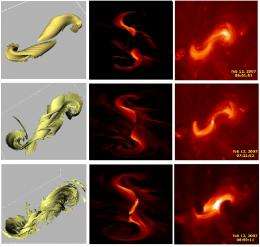Solar sigmoids explained

(PhysOrg.com) -- 'Sigmoids' are S-shaped structures found in the outer atmosphere of the Sun (the corona), seen with X-ray telescopes and thought to be a crucial part of explosive events like solar flares. Now a group of astronomers have developed the first model to reproduce and explain the nature of the different stages of a sigmoid’s life.
'Sigmoids' are S-shaped structures found in the outer atmosphere of the Sun (the corona), seen with X-ray telescopes and thought to be a crucial part of explosive events like solar flares. Now a group of astronomers have developed the first model to reproduce and explain the nature of the different stages of a sigmoid’s life. Professor Alan Hood and Dr. Vasilis Archontis, both from the Mathematical Institute at St. Andrews University, Scotland, will present the team’s results at the European Week of Astronomy and Space Science conference at the University of Hertfordshire. Prof. Hood will present some of the work in a talk on Monday 20th April, supplemented by a poster by Dr. Vasilis Archontis on Thursday 23rd April, which will cover the model in more detail.
Recently, the X-Ray Telescope (XRT) on board the Hinode space mission was used to obtain the first images of the formation and eruption phase of a sigmoid at high resolution. These observations revealed that the structure of the sigmoid is complex: it consists of many, differently oriented, loops that all together form two opposite J-like bundles or an overall S-shape. They also showed that at the end of its life the sigmoid produces a 'flare' eruption.
Over the years a series of theoretical and numerical models have been proposed to explain the nature of sigmoids but until now there was no explanation on how such complex structures form, erupt and fade away. The new model describes how sigmoids consist of many thin and twisted layers (or ribbons) of strong electric current. When these layers interact it leads to the formation of the observed powerful flares and the eruption of strong magnetic fields which carry highly energetic particles into interplanetary space.
Dr. Archontis sees the connection between the two astronomers’ model and work on predicting solar flares. He remarks, “Sigmoids work as 'mangers' or 'cocoons' for solar eruptions. There is a high probability that they will result in powerful eruptions and other explosive events. Our model helps scientists understand how this happens.”
Prof. Hood adds that these events have real significance for life on Earth, “Sigmoids are among the most interesting features for scientists trying to forecast the solar eruptions - events that can disrupt telecommunications, damage satellites and affect the way navigation systems are operated'.
Provided by Royal Astronomical Society (news : web)



















